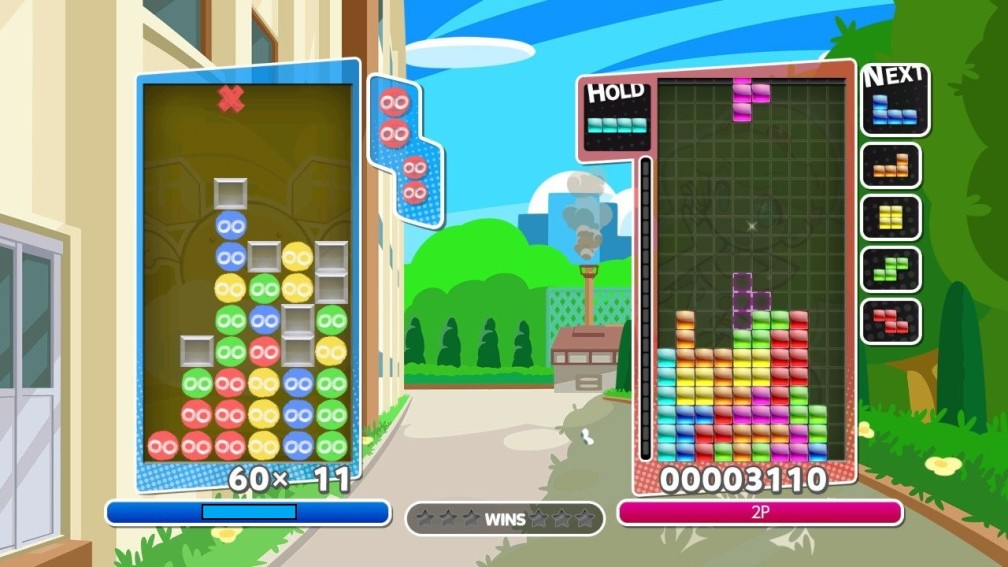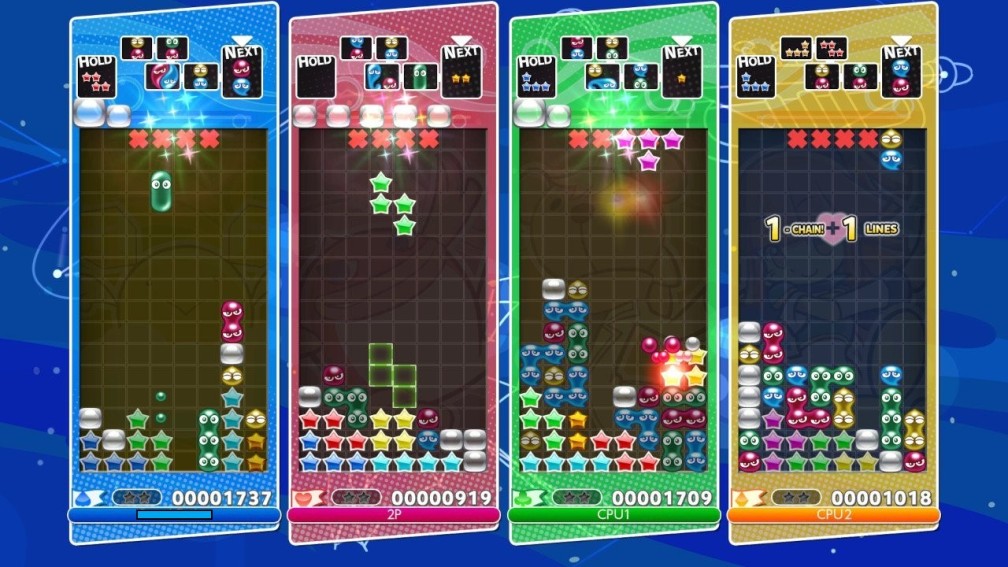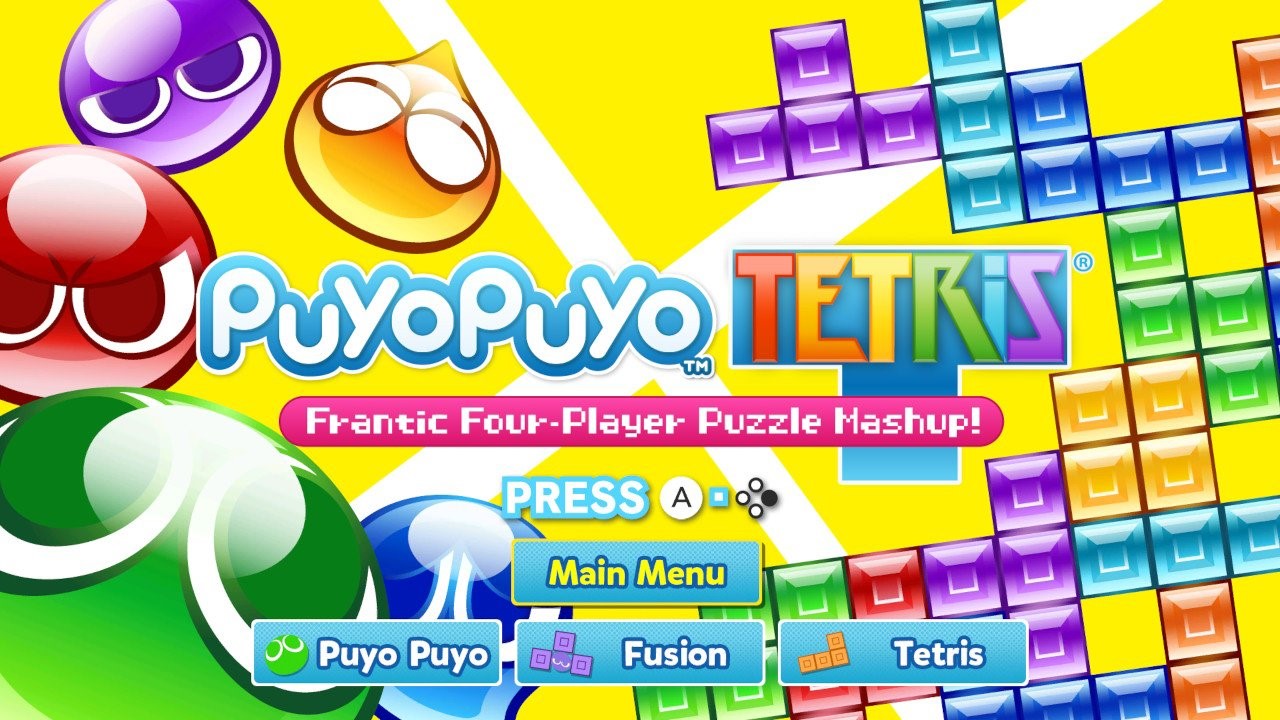Puyo Puyo Tetris
Pretty Pretty Terrific
Video game crossovers are familiar territory in the gaming world. On the Switch alone, we have Mario + Rabbids, Fire Emblem Warriors, and even the Blaster Master DLC characters. On paper, all of these examples probably sounded somewhat nonsensical. In the case of Mario + Rabbids, the internet collectively cringed when the concept art first leaked. However, each game has shown that the crossovers can be wildly successful, drawing on and combining the strengths of each included franchise. The end product may still be strange, but strange combos can still be good, just like fried chicken and waffles.

Although I imagine few people were clamoring for a Puyo Puyo/Tetris crossover prior to the release of Puyo Puyo Tetris (PPT), it’s not surprising that these two juggernauts could share a home together. Both series have produced some quality games, so you would hope that merging them could create an experience greater than its separate parts. That goal isn’t quite realized with PPT; in fact, the opposite may be true. Let’s make this clear: Puyo Puyo Tetris offers a great rendition of each series. That said, when the two try to mix, their resulting love child is less than pleasant.
What is it?
Most gamers are familiar with Tetris, having played it on a console, handheld, or calculator at some point in their lives. For those of you who haven’t played Tetris yet, you’re lying. You’ve played it. If you’re still insistent that you haven’t, Tetris places you in the role of a zookeeper who must feed his animals with limited supplies. In order to make matches, you must pair an animal with what it eats. Rhinos eat grass; lions eat rhinos; humans eat lions; and grass eat humans. Build up your food chain, and whoever’s zookeeper survives longest wins.
Comparatively, Puyo Puyo is less recognizable to a western audience. “Puyos” (little colored blobs) will fall down in pairs, which you can rotate just like tetrominoes. Your basic goal is to group together four or more same-colored puyos to make them disappear. Making matches is easy enough, but to win, you’ll need to make combos. Unlike tetrominoes, puyos follow the rules of gravity once placed and will fall to the bottom if there is space. This is the key to combos because you will want to arrange your puyos to create a domino effect. Ideally, once a match is made, the surrounding puyos will fall to create another match, which hopefully triggers another. Successful combos will send “trash puyos” raining on your opponent’s board. Trash puyos cannot create matches, and to remove them, you have to make matches beside them. As with Tetris, if your screen fills to the top with puyos, you lose.

Throughout numerous modes, Puyo Puyo and Tetris come together in three main flavors. In most modes, you and your opponents each choose to play either Puyo Puyo or Tetris alone, allowing you to abuse each other with your weapon of choice. Conversely, Swap Mode forces you to alternate between each puzzle game every thirty seconds. If you lose on one board, you lose the game. The novelty with Swap Mode is you can chain combos across your two board states when you swap, allowing you to hail hell on your opponents if you juggle your clears/matches correctly. Lastly, Fusion Mode throws both puyos and tetrominoes on a single board, and these pieces must be cleared just as you would in a normal mode. Block/blob placement is key because as the two mix, stringing together combos becomes less intuitive.
What’s good?
- Both Puyo Puyo and Tetris are inherently great games. Both can be picked up relatively easily, and both have the “one-more-round” addictiveness of crack cocaine. Unless you hate puzzle games or crack cocaine, you will enjoy one of these games. And if you happen to hate Puyo Puyo or Tetris, you can effectively ignore one half of PPT and still have a solid game.
- There are modes galore. For multiplayer alone, you have Versus, Party, Fusion, Swap, and Big Bang. For the lone player, you have those modes plus a story mode and challenges like Marathon, Tiny Puyo, and Sprint. The online features are pretty robust as well, and the online community is still active to this day.
- Swap mode is absurdly satisfying. I would venture to guess most players will have some skill with Tetris before playing PPT but will have barely touched Puyo Puyo. Swap allows for players to slowly grow accustomed to Puyo Puyo while still being able to compete with their Tetris skills. Once you have mastered both Tetris and Puyo Puyo, you’re introduced to the joy of blasting massive combos utilizing the swap mechanic.

What’s bad?
- Fusion is absolutely atrocious. Other reviewers have come to enjoy this mode, but try as I might, I haven’t been able to see its merit. Fusion theoretically adds another level of complexity by challenging you to manage your puyo matches and Tetris clears on the same board, but the result is less “rub your stomach and pat your head,” and more “shove your fist down your throat and shove your other fist down your throat.” As is the case with double-fisting your throat, Fusion feels frustrating, unintuitive, and boring.
- The Party and Big Bang modes are intriguing but don’t have much substance. Party mode focuses heavily on items which can temporarily speed up your opponents’ game, prevent them from rotating pieces, or generally screw up a normal board state. While good for a laugh, Party’s antics favor chaos over control, which will turn off many players. Big Bang, meanwhile, gives you pre-constructed boards which can be cleared with easy combos, and players compete to complete more boards than their opponents. Again, the mode is nifty but grows tiresome after a few rounds.
- Puyo Puyo Tetris lacks certain quality-of-life features present in previous games. Apart from Party, there is no multiplayer score attack mode. You can’t practice after you are knocked out of a round, a feature that can greatly help beginning players. You can’t select computer difficulties; instead, each character has a hidden difficulty level, and you’ll have to figure what this level is, supposedly by dating the character and developing your shared bond or something. Other features are missing, and although their absences do not necessarily ruin the game, PPT feels more like a debut game rather than a feature-rich entry expected of two long-running franchises.

What’s the verdict?
Puyo Puyo Tetris is a wholly solid game in hopefully what will become a continuing series. Whether you are attracted to blobs or blocks, PPT has something to appeal to your interests. It’s a game for all occasions: great on the go or on a TV, perfect for friends or by your lonesome, pitiable self, and appropriate for a quick round or for hours-long marathons. Apart from Swap, PPT doesn’t reinvent either puzzle series, but the marriage of these two franchises still makes for one of the best puzzle games on the Switch.
Arbitrary Statistics:
- Score: 8
- Time Played: 85 hours
- Number of Players: 1-4
- Games Like It on Switch: Magical Drop II, Tumblestone

